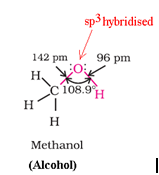
myCBSEguide App
Download the app to get CBSE Sample Papers 2023-24, NCERT Solutions (Revised), Most Important Questions, Previous Year Question Bank, Mock Tests, and Detailed Notes.
Install NowAlcohols Phenols and Ethers class 12 Notes Chemistry in PDF are available for free download in myCBSEguide mobile app. The best app for CBSE students now provides Alcohols Phenols and Ethers class 12 Notes latest chapter wise notes for quick preparation of CBSE board exams and school-based annual examinations. Class 12 Chemistry notes on chapter 11 Alcohols Phenols and Ethers are also available for download in CBSE Guide website.
Alcohols Phenols and Ethers Class 12 Notes Chemistry
Download CBSE class 12th revision notes for chapter 11 Alcohols Phenols and Ethers in PDF format for free. Download revision notes for Alcohols Phenols and Ethers class 12 Notes and score high in exams. These are the Alcohols Phenols and Ethers class 12 Notes prepared by team of expert teachers. The revision notes help you revise the whole chapter 11 in minutes. Revision notes in exam days is one of the best tips recommended by teachers during exam days.
Revision Notes for Class 12 Chemistry Download as PDF
CBSE Class 12 Chemistry Revision Notes Chapter 11 Alcohols, Phenols and Ethers
Structure of alcohols:
- Preparation of alcohols:
a) From alkene
b) From esters
c) From aldehydes and ketones
d) From carboxylic acids
- Structure of phenols:
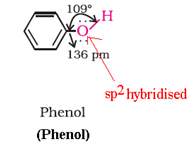
Preparation of phenols:
a) From benzene

b) From chlorobenzene

c) From cumene

d) From aniline

Physical properties of alcohols and phenols:
a) Boiling points: Boiling points of alcohols and phenols are higher in comparison to other classes of compounds. This is because the –OH group in alcohols and phenols is involved in intermolecular hydrogen bonding.
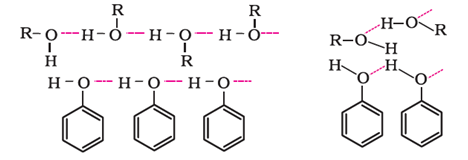
The boiling points of alcohols and phenols increase with increase in the number of carbon atoms. This is because of increase in van der Waals forces with increase in surface area.
In alcohols, the boiling points decrease with increase of branching in carbon chain. This is because of decrease in van der Waals forces with decrease in surface area.
b) Solubility: Solubility of alcohols and phenols are soluble in water due to their ability to form hydrogen bonds with water molecules. The solubility of alcohols decreases with increase in size of alkyl/aryl (hydrophobic) groups.
Chemical properties of alcohols:
I. Reactions involving cleavage of O–H bond: Alcohols react as nucleophiles:
a) Reaction with metals
b) Esterification reaction
II. Reactions of alcohols involving cleavage of carbon – oxygen (C–O) bond:
a) Reaction with hydrogen halides
b) Reaction with phosphorus trihalides
c) Dehydration reaction
d). Oxidation reaction
i)
ii)
iii)
- Chemical properties of phenols:
I. Reactions involving cleavage of O–H bond: Alcohols react as nucleophiles:
a) Reaction with metals

b) Esterification reaction
II. Other chemical reactions of phenols:
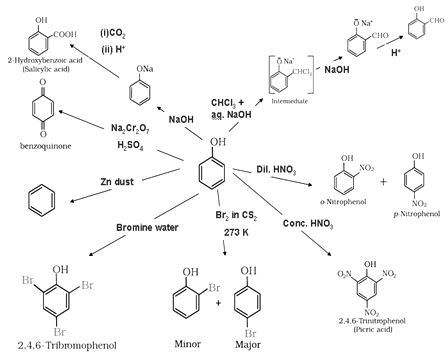
III. Acidic nature of phenol and alcohol:
a). Phenol > H2O > Primary alcohol > Secondary alcohol > Tertiary alcohol.
The acidic character of alcohols is due to the polar nature of O–H bond. Alkyl group is an electron-releasing group (–CH3, –C2H5) or it has electron releasing inductive effect (+I effect). Due to +I effect of alkyl groups, the electron density on oxygen increases. This decreases the polarity of O-H bond. And hence the acid strength decreases.

b) Phenol is more acidic than alcohol: In phenol, the hydroxyl group is directly attached to the sp2hybridised carbon of benzene ring which acts as an electron withdrawing group whereas in alcohols, the hydroxyl group is attached to the alkyl group which have electron releasing inductive effect. In phenol, the hydroxyl group is directly attached to the sp2hybridised carbon of benzene ring whereas in alcohols, the hydroxyl group is attached to the sp3hybridised carbon of the alkyl group. The sp2hybridised carbon has higher electronegativity than sp3hybridised carbon. Thus, the polarity of O–H bond of phenols is higher than those of alcohols. Hence, the ionisation of phenols is higher than that of alcohols.
The ionisation of an alcohol and a phenol takes place as follows:
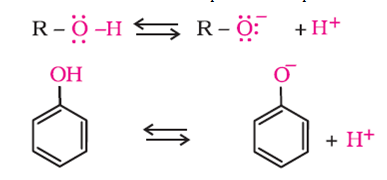
In alkoxide ion, the negative charge is localised on oxygen while in phenoxide ion, the charge is delocalised.

The delocalisation of negative charge makes phenoxide ion more stable and favours the ionisation of phenol. Although there is also charge delocalisation in phenol, its resonance structures have charge separation due to which the phenol molecule is less stable than phenoxide ion.

c) In substituted phenols, the presence of electron withdrawing groups such as nitro group enhances the acidic strength of phenol. On the other hand, electron releasing groups, such as alkyl groups, in general, decreases the acid strength. It is because electron withdrawing groups lead to effective delocalisation of negative charge in phenoxide ion.
Differentiate between organic compounds:
a) Alcohols and phenols
Phenol on reaction with neutral FeCl3 gives purple colour whereas alcohols do not give purple colour.
b) Primary, secondary and tertiary alcohols
Lucas reagent test:
If it is a primary alcohol, no turbidity appears at room temperature. Turbidity appears only on heating. If it is a secondary alcohol, turbidity appears in 5 minutes. If it is a tertiary alcohol, turbidity appears immediately.
c) Methanol and ethanol
Iodoform test: Ethanol when reacted with (I2 and NaOH) or NaOI gives yellow ppt of iodoform since it has the presence of CH3-CH (OH)- group.
- Structure of ethers:
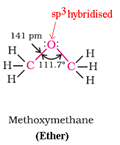
- Preparation of ethers:
a) From alcohols
b) From alkyl halide and sodium alkoxide
Here, the alkyl halide should be primary and alkoxide should be tertiary. In case of aromatic ether, the aromatic part should be with phenoxide ion.
Physical properties of ethers
a) Miscibility: Miscibility of ethers with water resembles those of alcohols of the same molecular mass. This is due to the fact that just like alcohols, oxygen of ether can also form hydrogen bonds with water molecule.

b) Boiling points:
Ethers have much lower boiling points than alcohols. This is due to the presence of hydrogen bonding in alcohols. Hydrogen bonding is absent in ethers.

Chemical properties of ethers:
a) Cleavage of C–O bond in ethers:
R-O-R’ + HX → R-X + R’OH
Excess
The order of reactivity of hydrogen halides is as follows: HI >HBr>HCl
Alkyl halide formed is always the lower alkyl group. But if a tertiary alkyl group is present, the alkyl halide is always tertiary. In case of phenolic ethers, the cleavage occurs with the formation of phenol and alkyl halide.
b) Electrophilic substitution reaction in aromatic ethers:

The electrophilic substitution reaction of aromatic ether involves the following reaction:
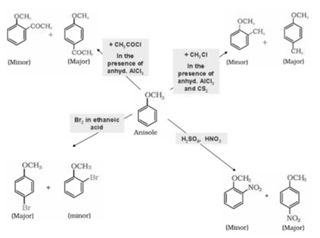
- Other conversion reactions:
a) Phenol to salicyldehyde
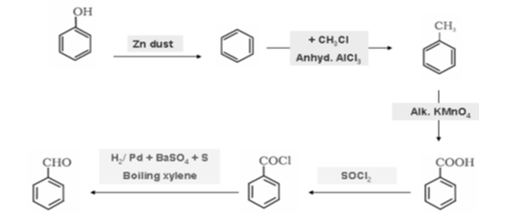
b) Phenol to benzene diazonium chloride
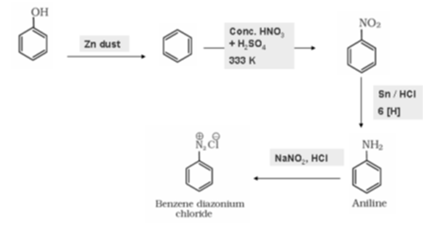
CBSE Class-12 Revision Notes and Key Points
Alcohols Phenols and Ethers class 12 Notes. CBSE quick revision note for class-12 Chemistry, Physics Math’s, Biology and other subject are very helpful to revise the whole syllabus during exam days. The revision notes covers all important formulas and concepts given in the chapter. Even if you wish to have an overview of a chapter, quick revision notes are here to do if for you. These notes will certainly save your time during stressful exam days.
- Physics
- Chemistry
- Mathematics
- Biology
- Accountancy
- Economics
- Business Studies
- Computer Science
- Informatics Practices
- English Core
- History
- Physical Education
To download Alcohols Phenols and Ethers class 12 Notes Chemistry sample paper for class 12 Physics, Chemistry, Biology, History, Political Science, Economics, Geography, Computer Science, Home Science, Accountancy, Business Studies and Home Science; do check myCBSEguide app or website. myCBSEguide provides sample papers with solution, test papers for chapter-wise practice, NCERT Alcohols Phenols and Ethers, NCERT Exemplar Alcohols Phenols and Ethers, quick revision notes for ready reference, CBSE guess papers and CBSE important question papers. Sample Paper all are made available through the best app for CBSE students and myCBSEguide website.
- Solid State class 12 Notes Chemistry
- Solutions class 12 Notes Chemistry
- Electrochemistry class 12 Notes Chemistry
- Chemical Kinetics class 12 Notes Chemistry
- Surface Chemistry class 12 Notes Chemistry
- General Principles and Processes of Isolation of Elements class 12 Notes Chemistry
- The p-Block Elements class 12 Notes Chemistry
- The d- and f- Block Elements class 12 Notes Chemistry
- Coordination Compounds class 12 Notes Chemistry
- Haloalkanes and Haloarenes class 12 Notes Chemistry
- Aldehydes Ketones and Carboxylic Acids class 12 Notes Chemistry
- Amines class 12 Notes Chemistry
- Biomolecules class 12 Notes Chemistry
- Polymers class 12 Notes Chemistry
- Chemistry in Everyday Life class 12 Notes Chemistry

Test Generator
Create question paper PDF and online tests with your own name & logo in minutes.
Create Now
myCBSEguide
Question Bank, Mock Tests, Exam Papers, NCERT Solutions, Sample Papers, Notes
Install Now